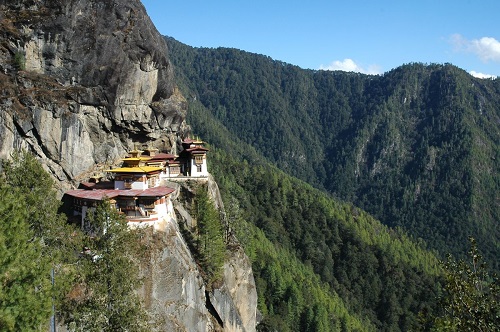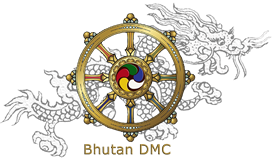Paro (altitude 2,280m) - Home to the fabled Tiger’s Nest and Bhutan’s only International Airport
Situated at an altitude of 2,280m in north-western part of the country and covering an area of 1293 sq. km, the bucolic Paro valley used to be historically the centre of two of the most important trade routes to Tibet. Home to several prominent temples and monasteries, the country’s only international airport is located in Paro. Here the Paro Chhu (river) flows south from its watershed in the Mount. Chomolhari (7,314m) range while the national highway links the town to southern frontier town of Phuentsholing and capital city Thimphu amid a patchwork of rice paddies, trout-filled steams and scattered settlements.
Places of Tourist Interest in Paro valley
Rinpung Dzong (Paro Dzong)
Built in 1646 by Zhabdrung Ngawang Namgyal on old foundations, this imposing five-storey building has a long and fascinating history. A monastery was first built on the site by Guru Padmasambhava at the beginning of 10th century. When in future years, the legend goes, a lama went into the forest to prepare plans for a chapel, he uttered the mantra ‘Hun’ and the planks miraculously moved towards site, on their own. Work on the Hunrey Gompa on the site, was carried out by villagers by day and continued at night by spirits-and the hoofmarks left by their horses are still visible there today as evidence.
Built with stones instead of clay, the dzong was named Rinpung, meaning ‘heap of jewels’. Tragically, Rinpung Dzong and all its treasures were destroyed by fire in 1907 and rebuilt by the Penlop Dawa Penjor right after the fire. Housed within its walls is a collection of sacred masks and costumes some dates back several centuries while others were contributed by Dawa Penjor and his successor Penlop Tshering Penjor in recent times. Rinpung Dzong is also venue of popular Paro Tshechu (festival), held once a year during spring.

Taktshang (Tiger Nest) Monastery
The gem-like Taktsang Monastery, clinging to a sheer 3,000 feet high granite cliff over Paro valley, is one of the most impressive sites in the Himalayas and of great religious significance. The name of gravity defying cluster of buildings means literally ‘the Tiger Nest’ an allusion to the popular legend that Guru Padmasambhava flew here from Tibet on the back of a Tiger. Today pilgrims and other visitors reach it in a more earthbound but no less dramatic fashion.
The hike to the monastery can be summarised into three stages. The first stage is the trek to the cafeteria which is situated on a rocky outcrop across a ravine from the monastery. This leg of the trek takes approximately 45 to 60 minutes, depending on your level of fitness. Horses (really only small ponies) can be arranged for this leg. At the cafeteria one can stop for some tea & coffee whilst pondering the journey ahead and looking at the monastery in the distance.
The 2nd stage of the walk is from the cafeteria to the lookout opposite the monastery. This leg takes close to one hour. At this point some may be content to snap photos and then return to the cafeteria.
The 3rd stage is the trek/climb down the 475 steps in the cliff face to the bottom of the ravine which crosses over a stream and waterfall before the path again ascends another 300 odd steps to the entrance of the monastery. Once here, one can enter into the monastery and view the cave where Zhabdrung Ngawang Namgyal meditated. The visit and climb to the entrance and back to the lookout will take approximately one hour.
Ta Dzong
Located on the hill above Paro Dzong stands this ancient watchtower which has been, since 1967, the national museum of Bhutan. It holds fascinating collection of art, relics, religious thangkha paintings and Bhutan’s exquisite postage stamps. The museum circular shape augments its varied collection displayed over several floors.
Kichu Lhakhang
Kichu is considered one of the holiest and the oldest shrines of the Kingdom dating back to 7th century (the other is Jambey Lhakhang in Bumthang). The lhakhang complex is composed of two temples. The first temple was built by Tibetan King, Songtsen Gampo in the 7th century and in 1968, H.M. Ashi Kesang, the Queen Mother of Bhutan, built the second temple in same original pattern. In the seventh century, Tibet was ruled by King Songsten Gompo, who in his attempt to suppress a demoness opposing Buddhist teachings built 108 temples in a day and Kichu is one of them.
Dungtse Lhakhang
Built in 1433 by iron bridge builder, Thangtong Gyalpo, this chorten like temple is located to the west of the road. It has three floors representing hell, earth and heaven. The paintings inside the temple are considered to be some of the best in Bhutan.
Drukgyel Dzong
Built by Zhabdrung Ngawang Namgyal in 1646 to commemorate an early military victory over Tibetan invaders, the dzong name means, indeed, ‘victorious Druk’. Historically and strategically, this Dzong withstood all its glory and was featured in 1914 vide National Geographic magazine. The glory of Drukgyel Dzong remained even when it was destroyed by fire in 1951. On a clear day, one can see the commanding view of Mount. Chomolhari (7,314m) from the village, below the Dzong. The restoration work of Drukgyel Dzong is currently under progress and scheduled to be completed by year 2022.
Jangsarbu Lhakhang
Located behind Paro Dzong, this small temple is home to a magnificent statue of Sakyamuni Buddha that was carried all the way from Lhasa and also houses the protector deity of Paro. Legend has it that the statue of Sakyamuni was destined for Paro Dzong and merely placed in the temple for overnight safe keeping. However, when the time came to move the statue, it proved impossible to lift. As a result, it became a permanent feature of the lhakhang.
Tamchog Goenpa
Located towards the lower valley of Paro, in the small village of Tagchoe Balakha situated this monastery, built by Drupchen Thangtong Gyalpo known as iron bridge builder of Bhutan. He built eight iron bridges in Bhutan also established the monastery of Dungtse in the central valley of Paro. The remains of the iron chains used for building bridges are still secure in Tamchog monastery as a sacred monument.
Ugyen Pelri Palace
Across a medieval bridge below the Paro Dzong stands the Ugyen Pelri Palace, a Royal residence constructed by Penlop Tshering Penjor and fashioned after the heavenly abode of revered Guru Rinpoche. The palace was designed, and all the architectural details were supervised by the Penlop himself and it is a real masterpiece of design and decoration.
Druk Choeding
Built in 1525, this town temple was formed by Ngawang Chhogyel, one of the prince-abbots of Ralung in Tibet and an ancestor of the Zhabdrung Ngawang Namgyal.
Hikes and Excursions in and around Paro valley
Dzongdrakha Goenpa
Often called as mini-Taktsang, Dzongdrakha is a cliff-side temple complex on the western side of Paro valley. Four shrines make up the complex, dedicated to Drolma (Tara), Tsheringma (Goddess of Longevity), Guru Rinpoche and the Buddha of the Future, Maitreya. Local oral tradition states that when Guru Rinpoche first came to Bhutan, he came from Nepal, first landing at Drakarpo, and then Dzongdrakha before arriving at Taktsang (Tiger’s Nest) farther north up the valley. Located approx. 20-minute drive from Paro, these temples are built on a cliff above Bondey village, but the walk is not as strenuous as Taktsang. From the road, it takes only about 30 minutes to reach here.
Chelela pass
At an elevation of 3,988 meters, Chelela is considered to be one of the highest motorable passes in Bhutan. About an hour’s drive along a thickly forested road, this pass is a botanical paradise. The pass provides stunning views of the sacred mountain Chomolhari and Jichu Drake. It is also marked by hundreds of prayer flags fluttering in the wind. Here, visitors can see cascades of wild roses, purple and yellow primulas and swathes of deep blue iris covering the forest cover. During the season, the top of the pass bloom with rhododendrons in a variety of colours-pale pink, deep pink, burnt orange, mauve, white and scarlet.
Kila Goenpa
It is the serene home of Buddhist nuns who have dedicated their life for spiritual fulfilment and leading undisturbed life of religious studies, prayer and meditation. The monastery is nestled in a craggy patch on mountain side below the Chelela pass and perched precariously along the rock face. From Chelela pass, the lhakhang is about an hour walk amidst magnificent, wooded area.
Choedin Village Loop
Start the walk near Drukgyel Dzong towards the Sagala pass. Following the dirt road, you reach the charming and petite Choedin village. From here, a trail sets off upwards through dense pine forest until reaching the ruins of Choedin Lhakhang at the top of the hill. Enjoy and admire the perfect views of Paro Valley, Tiger Nest and the thousands of pine trees. Later the trail leads you down to Tshento village just by Drukgyel Dzong. The loop can be completed in about three hours.
HOTELS IN THIMPHU
HOTELS IN PUNAKHA & WANGDUE
HOTELS IN GANGTEY
HOTELS IN TRONGSA
HOTELS IN BUMTHANG
HOTELS IN MONGAR
HOTELS IN TRASHIGANG
HOTELS IN SAMDRUP JONGKHAR
HOTELS IN PHUENTSHOLING
HOTELS IN HAA
HOTELS IN GELEPHU
HOTELS IN ZHEMGANG
RESTAURANTS IN PARO
RESTAURANTS IN THIMPHU
RESTAURANTS IN PUNAKHA
TOUR ITINERARIES
TREKKING ITINERARIES
SPECIAL INTERESTS TOURS
UNIQUE FESTIVALS & FAIRS
BLOG


